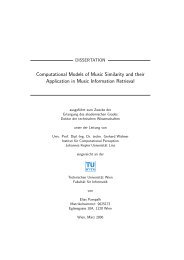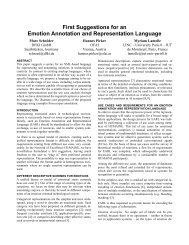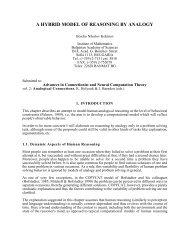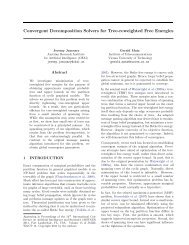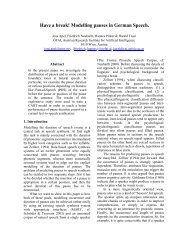Global Musical Tempo Transformations using Case Based ... - OFAI
Global Musical Tempo Transformations using Case Based ... - OFAI
Global Musical Tempo Transformations using Case Based ... - OFAI
You also want an ePaper? Increase the reach of your titles
YUMPU automatically turns print PDFs into web optimized ePapers that Google loves.
from the performance IOI’s. The first alternative shows mainly small time<br />
scale timing deviations, and obscures trends, or larger time scale changes in<br />
timing (such as rubato). The second alternative shows such global trends<br />
more clearly. The second definition, ‘expression as deviation from the score’,<br />
is realized as the deviations of IOI’s from the mean note or beat duration.<br />
The results are equivalent to those of the first definition. Measurement of expressiveness<br />
according to the third definition, ‘expression as deviation within<br />
a performance’, is performed by relating the performed note IOI’s to the performed<br />
bar IOI’s. This approach can clarify timing regularities that relate<br />
to meter and rhythmical patterns.<br />
2.1.2 Representation of Timing and <strong>Tempo</strong><br />
Related to the issue of interpreting different aspects of expressivity is the<br />
argument for differentiation of tempo changes and timing [62, 13]. Although<br />
both tempo changes and timing become manifest through temporal displacement<br />
of musical events, they refer to different musical phenomena. <strong>Tempo</strong><br />
changes refer to the effect of speeding up or slowing down the performance<br />
of the melody in a continuous manner, whereas timing refers to local displacements<br />
of notes, chords or other musical events, with respect to the<br />
tempo (in a manner of speaking, timing is on top of tempo changes). Honing<br />
[62] notes that representations commonly used for describing musical performances<br />
(like tempo-curves that map score times to instantaneous tempo,<br />
or time-shift functions that map score times to deviations with respect to the<br />
score) fail to capture both aspects separately. As a result, they cannot well<br />
be used in systems for performance generation, since applying such functions<br />
in composition (that is, apply one function on the result of another function)<br />
yields undesired results. This is caused by the fact that the input of the<br />
second function is not score-time but performance time. Time maps (TM’s)<br />
are a better solution for such applications. A TM maps performance time<br />
before transformation (pre-perturbed time) to performance time after transformation<br />
(perturbed time), which allows for composition. Another practical<br />
advantage of TM’s over tempo-curves or time-shift functions is that the former<br />
provides performance time directly as output, whereas the latter two<br />
require extra calculation to obtain performance time. However, TM’s also<br />
have some limitations:<br />
• Score times are lost in composition<br />
• Support for concatenation is limited<br />
• Access to score and performance durations in composition<br />
19




